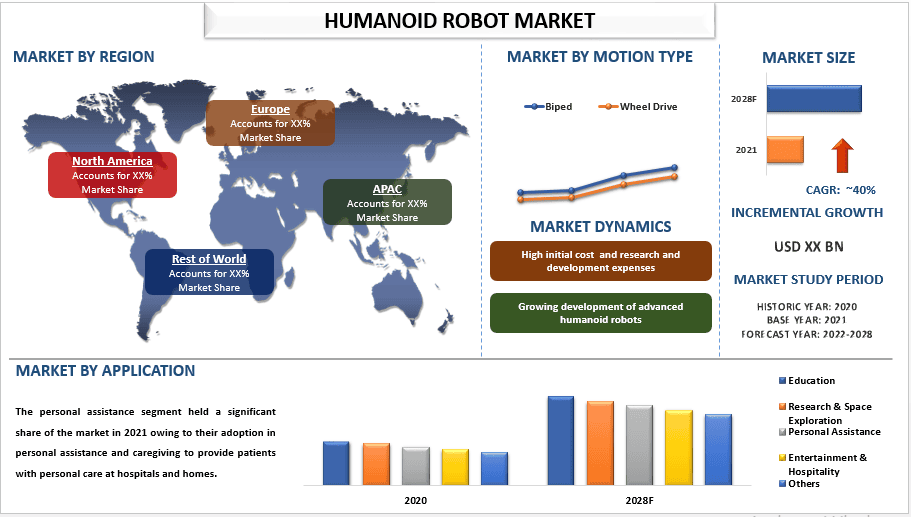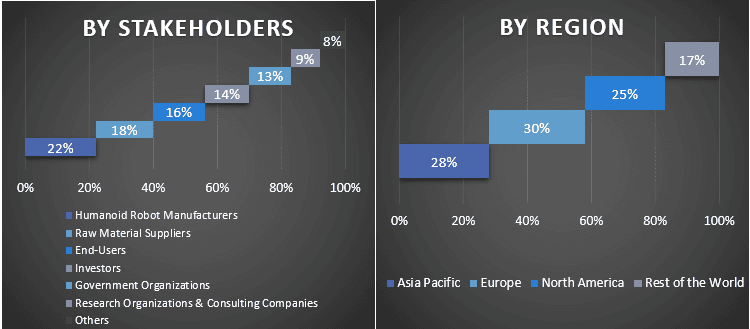Humanoid Robot Market: Current Analysis and Forecast (2022-2028)
Emphasis on Motion Type (Biped and Wheel Drive); Application (Education, Research and Space Exploration, Personal Assistance, Entertainment & Hospitality, and Others); and Region/Country

The Humanoid Robot Market is expected to grow at a strong CAGR of around 50% during the forecast period owing to the growing need for personal assistance humanoid robots in the retail business. The shape of a humanoid robot is similar to that of a human body. These robots are proficient assistance robots worked for connection with human apparatuses and client support. Additionally, these humanoid robots are utilized for maintenance and inspection; They are not made of flesh or bones, but they do have eyes and skin. The most recent versions can walk, talk, and show a wide range of emotions like humans. In addition, humanoid robots are utilized by businesses to provide high levels of work efficiency and replace human labor. In numerous business spaces, it is likewise useful for diversion purposes and performing undertakings for amusement purposes. A humanoid robot is like a human body in shape. Professional service robots are designed to interact with human tools and provide customer service. Additionally, these humanoid robots are utilized for maintenance and inspection; they have skin and eyes, yet they are not made of tissue or bones. The furthest down the line cycles can talk like people, walk like people, and express many feelings. In addition, humanoid robots are utilized by businesses to provide high levels of work efficiency and replace human labor. It can also be used for entertainment and performing tasks for entertainment in many commercial spaces. Additionally, the increasing investment of governments in AI and robotics companies is also propelling the growth of the humanoid robot market. For instance, Sanctuary Cognitive Systems Corporation, a Vancouver-based company that specializes in AI and robotics, recently received an investment of CAD 30 million from the federal Minister of Innovation, Science, and Industry, François-Philippe Champagne.
Some of the major players operating in the market include Honda Motor Co., Ltd.; TOYOTA MOTOR CORPORATION; SoftBank Robotics Group; UBTECH ROBOTICS CORP LTD.; PAL Robotics; KAWADA ROBOTICS CORPORATION; Hajime Research Institute, Ltd.; HANSON ROBOTICS LTD.; Boston Dynamics; and Engineered Arts Ltd. Several M&As along with partnerships have been undertaken by these players to facilitate customers with hi-tech and innovative products/technologies.
Insights Presented in the Report
“Amongst motion type, the wheel drive segment held a prominent share of the market in 2021”
Based on the motion type, the market is classified into biped and wheel drive. Amongst these, the wheel drive segment dominated the market in 2021 and is expected to grow at a substantial CAGR during the forecast period. The demand for wheel drive robots in the military and defense sectors, as well as in amusement parks, science fairs, and theme parks, are among the primary drivers of the market’s expansion. Wheel drive robots are excellent tools for doing simple things like moving things from one location to another or more difficult things like increasing a robotic arm’s range. Wheeled robots are typically inexpensive and easy to build.
“Amongst application, the personal assistance segment held a dominating share of the market in 2021”
By application, the market is divided into education, research & space exploration, personal assistance, entertainment & hospitality, and others. The personal assistance segment held a significant share of the market in 2021. The adoption of humanoid robots for personal assistance purposes has gained traction in recent years. With advanced capabilities such as voice recognition, natural language processing, and machine learning, these robots can assist with daily tasks and provide companionship to their users.
“APAC to lead the market growth during the forecast period”
APAC is expected to grow at a strong CAGR during the forecast period mainly due to the growing elderly population in countries such as China and Japan. The region is expected to employ humanoids for personal assistance and caregiving applications. Moreover, the increasing number of product launches in the humanoid market is further contributing to the growth of the humanoid robot market in APAC. For instance, in June 2021, Hanson Robotics, the Hong Kong team behind the celebrity humanoid robot Sophia launched a new prototype, Grace, targeted at the healthcare market and designed to interact with the elderly and those isolated by the COVID-19 pandemic.
Reasons to buy this report:
- The study includes market sizing and forecasting analysis validated by authenticated key industry experts.
- The report presents a quick review of overall industry performance at one glance.
- The report covers an in-depth analysis of prominent industry peers with a primary focus on key business financials, product portfolios, expansion strategies, and recent developments.
- Detailed examination of drivers, restraints, key trends, and opportunities prevailing in the industry.
- The study comprehensively covers the market across different segments.
- Deep dive regional level analysis of the industry.
Customization Options:
The global Humanoid Robot market can further be customized as per the requirement or any other market segment. Besides this, UMI understands that you may have your own business needs, hence feel free to connect with us to get a report that completely suits your requirements.
Table of Contents
Research Methodology for the Humanoid Robot Market Analysis (2022-2028)
Analyzing the historical market, estimating the current market, and forecasting the future market of the global humanoid robot market were the three major steps undertaken to create and analyze the adoption of humanoid robots in major regions globally. Exhaustive secondary research was conducted to collect the historical market numbers and estimate the current market size. Secondly, to validate these insights, numerous findings and assumptions were taken into consideration. Moreover, exhaustive primary interviews were also conducted, with industry experts across the value chain of the global humanoid robot market. Post assumption and validation of market numbers through primary interviews, we employed a top-down/bottom-up approach to forecasting the complete market size. Thereafter, market breakdown and data triangulation methods were adopted to estimate and analyze the market size of segments and sub-segments of the industry pertains to. Detailed methodology is explained below:
Analysis of Historical Market Size
Step 1: In-Depth Study of Secondary Sources:
Detail secondary study was conducted to obtain the historical market size of the humanoid robot market through company internal sources such as annual reports & financial statements, performance presentations, press releases, etc., and external sources including journals, news & articles, government publications, competitor publications, sector reports, third-party database, and other credible publications.
Step 2: Market Segmentation:
After obtaining the historical market size of the Humanoid Robot market, we conducted a detailed secondary analysis to gather historical market insights and share for different segments & sub-segments for major regions. Major segments are included in the report as motion type and application. Further country-level analyses were conducted to evaluate the overall adoption of testing models in that region.
Step 3: Factor Analysis:
After acquiring the historical market size of different segments and sub-segments, we conducted a detailed factor analysis to estimate the current market size of the humanoid robot market. Further, we conducted factor analysis using dependent and independent variables such as motion type and application of the humanoid robot market. A thorough analysis was conducted for demand and supply-side scenarios considering top partnerships, mergers and acquisitions, business expansion, and product launches in the humanoid robot market sector across the globe.
Current Market Size Estimate & Forecast
Current Market Sizing: Based on actionable insights from the above 3 steps, we arrived at the current market size, key players in the global humanoid robot market, and market shares of the segments. All the required percentage shares split, and market breakdowns were determined using the above-mentioned secondary approach and were verified through primary interviews.
Estimation & Forecasting: For market estimation and forecast, weights were assigned to different factors including drivers & trends, restraints, and opportunities available for the stakeholders. After analyzing these factors, relevant forecasting techniques i.e., the top-down/bottom-up approach were applied to arrive at the market forecast for 2028 for different segments and sub-segments across the major markets globally. The research methodology adopted to estimate the market size encompasses:
- The industry’s market size, in terms of revenue (USD) and the adoption rate of the humanoid robot market across the major markets domestically
- All percentage shares, splits, and breakdowns of market segments and sub-segments
- Key players in the global humanoid robot market in terms of products offered. Also, the growth strategies adopted by these players to compete in the fast-growing market
Market Size and Share Validation
Primary Research: In-depth interviews were conducted with the Key Opinion Leaders (KOLs) including Top Level Executives (CXO/VPs, Sales Head, Marketing Head, Operational Head, Regional Head, Country Head, etc.) across major regions. Primary research findings were then summarized, and statistical analysis was performed to prove the stated hypothesis. Inputs from primary research were consolidated with secondary findings, hence turning information into actionable insights.
Split of Primary Participants in Different Regions

Market Engineering
The data triangulation technique was employed to complete the overall market estimation and to arrive at precise statistical numbers for each segment and sub-segment of the global humanoid robot market. data was split into several segments & sub-segments post studying various parameters and trends in the areas of the motion type and application in the global humanoid robot market.
The main objective of the Global Humanoid Robot Market Study
The current & future market trends of the global humanoid robot market were pinpointed in the study. Investors can gain strategic insights to base their discretion for investments on the qualitative and quantitative analysis performed in the study. Current and future market trends determined the overall attractiveness of the market at a regional level, providing a platform for the industrial participant to exploit the untapped market to benefit from a first-mover advantage. Other quantitative goals of the studies include:
- Analyze the current and forecast market size of the humanoid robot market in terms of value (USD). Also, analyze the current and forecast market size of different segments and sub-segments
- Segments in the study include areas of the motion type and application
- Define and analysis of the regulatory framework for the humanoid robot industry
- Analyze the value chain involved with the presence of various intermediaries, along with analyzing customer and competitor behaviors of the industry
- Analyze the current and forecast market size of the humanoid robot market for the major region
- Major countries of regions studied in the report include Asia Pacific, Europe, North America, and the Rest of the World
- Company profiles of the humanoid robot market and the growth strategies adopted by the market players to sustain in the fast-growing market
- Deep dive regional level analysis of the industry
Related Reports
Customers who bought this item also bought










